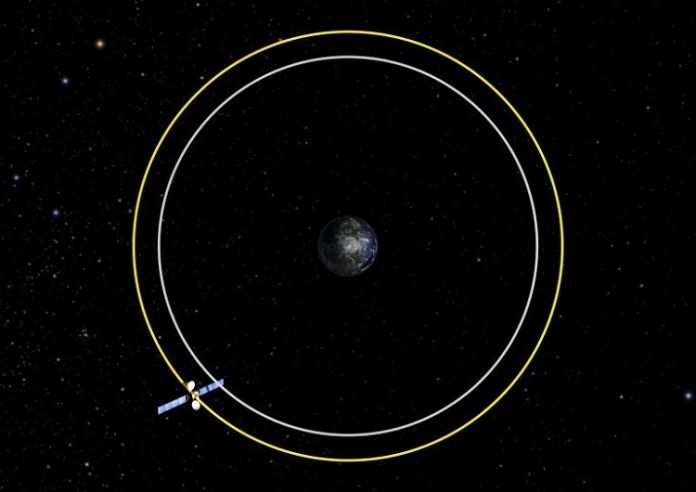
A Chinese satellite pulled a defunct navigation satellite out of the way of other satellites on January 22.
The satellite, called SJ-21, appeared to operate as a space tug when it grappled onto the navigation satellite from the Chinese CompassG2 network.
The operation details didn’t come from Chinese authorities but from a report by ExoAnalytic Solutions, a commercial space monitoring company.
Chinese authorities are tight-lipped about the operation, but what can observations tell us about Chinese capabilities?
Earth’s geosynchronous orbit is crowded, so on the face of it, having one less piece of space debris is a good thing for all satellite operators.
But people can get suspicious when China does something like this. Is suspicion warranted?
The details of the operation are in a report from ExoAnalytic Solutions that was presented in a webinar hosted by the Center for Strategic and International Studies (CSIS) and the Secure World Foundation (SWF.) Brian Flewelling from ExoAnalytic presented the report.
ExoAnalytic Solutions owns and operates more than 30 observatories and more than 300 telescopes worldwide.
The company says they monitor the full 360 degrees of the GEO belt and the graveyard region. Their Global Telescope Network is the world’s largest network of optical telescopes.
According to the company’s website, they provide “…ubiquitous, automated, real-time space domain awareness for space superiority.”
Here’s what happened, according to ExoAnalytic Solutions.
On January 22, SJ21 went absent from its orbital slot for several hours. Before that, it performed close proximity operations with the defunct CompassG2 satellite, moving closer and closer. SJ21 docked with the dead satellite, but ExoAnalytics didn’t observe the actual docking.
The docking took place in daylight when the company’s telescopes couldn’t image the satellite. ExoAnalytics reacquired SJ21 after it pulled the inoperative satellite out of geosynchronous orbit.
A video from ExoAnalytic Solutions explains their observations.
The China Aerospace Science and Technology Corporation (CASC) operates JS-21 (Shijian-21), but they haven’t been very open about the satellite’s operations and capabilities.
They launched the satellite on October 24, and China’s Xinhua news agency said, “The satellite will be mainly used to test and verify space debris mitigation technologies.”
Space debris is a growing problem, so any efforts to mitigate it are welcome. But China is tight-lipped about it. Compare their lack of details with other countries’ space debris mitigation efforts.
The ESA has a comprehensive web presence detailing its ongoing efforts to deal with space debris. Individual articles describe using drag sails to deorbit dead satellites, graphics explain the problem, and interviews with experts flesh out the whole issue. NASA is similar.
The Canadian Space Agency also practices openness, especially when their a piece of space debris struck the Canadarm2 robotic arm in April 2021.
The United Nations’ Space Debris Mitigation Guidelines apply to all UN member states, including China.
It can be challenging for citizens of western democracies to understand why China would be so secretive about something as innocuous as space debris mitigation. But China practices secrecy and obfuscation as a matter of course.
What do SJ-21’s operations mean? First of all, this isn’t the first time SJ-21 has been in the news. In November, it attracted attention when the U.S. Space Force’s 18th Space Control Squadron watched as the satellite orbited alongside another object.
The 18th SCS said the object was probably a spent apogee kick motor. Typically, a rocket puts a satellite into a transfer orbit, and an apogee kick motor on the satellite itself provides the final thrust to bring the satellite into geostationary orbit.
China never confirmed it.
Other space agencies are concerned that China could use SJ-21 to interfere with operational satellites from other countries. Whether or not that’s China’s intent, the suspicion won’t go away.
The U.S. Air Force’s China Aerospace Institute is a think tank that examines China’s activities in space.
The institute released a report in December 2021 focusing on SJ-21: “… one can reasonably argue that SJ-21 is probably going to be China’s second On-Orbit Servicing, Assembly, and Manufacturing (OSAM) practice-series satellite (Shijian) in GEO,” the report says.”
“One could also reasonably expect SJ-21 to advance work China has already done in lower orbits to practice rendezvous and proximity operations (RPOs) and the use of a robotic arm,” the report says.
“This time, China might practice using multiple arms, a different type of debris mitigation technology such as that needed for refueling or deorbiting, or a combination of those, based on Chinese academic publications…”
But the report also says that “China’s activities in OSAM have not been examined in-depth to date.”
China is framing SJ-21 as part of their On-Orbit Servicing, Assembly, and Manufacturing (OSAM) operations. But is there something more to it?
In an article at Breaking Defense, Jonathan McDowell, an astrophysicist at the Harvard-Smithsonian Center for Astrophysics, pointed out something unusual in SJ-21’s activities. McDowell said that the satellite’s orbit “…is highly elliptical, ranging from 36,076 km in altitude to 38,886 km.”
Satellites are moved into the graveyard orbit when it’s easier to boost them into that orbit than to deorbit them. Satellites can stay in the graveyard orbit for millions of years.
The graveyard orbit is about 300 km above the geostationary orbit, about 36,000 km. But JS-21 moved its dead passenger into an elliptical orbit that takes it well beyond that.
“Usually, GEO graveyard raising is done more symmetrically,” McDowell explained in the Breaking Defense article.
ExoAnalytic Solutions reported that SJ-21 is now back in a geosynchronous orbit. So was this a harmless debris mitigation maneuver?
If it was, why hasn’t China said so? Do they like keeping other countries in the dark, just in case? Is something potentially sinister going on? Asking these questions isn’t to invite conspiracy theories. This is global politics.
China isn’t the only one to develop and employ satellites like this. The Northrop-Grumman company developed their MEV-1 (Mission Extension Vehicle 1) satellite to help mitigate space debris.
But the MEV-1 is designed to dock with customers’ satellites and re-fuel them to extend their lives. They can’t use that capability offensively. Could SJ-21 be a precursor to offensive satellite operations? People are reluctant to say that publicly, but must be wondering behind closed doors.
This could all be much ado about nothing. Many space agencies are putting more resources into space debris mitigation.
It’s sensible operationally, scientifically, and economically. Maybe SJ-21 is purely a business venture, and China is keeping their cards close to their chest to protect any hoped-for economic advantage. But NASA, the ESA, and others are far more open about their activities.
Why so tight-lipped, China? Maybe they’re just following Sun-Tzu’s advice when he said, “Let your plans be dark and impenetrable as night …”
Written by Evan Gough.
Source: Universe Today.



